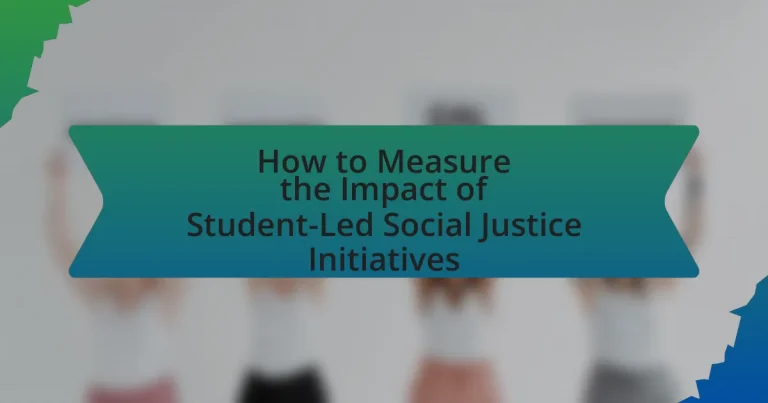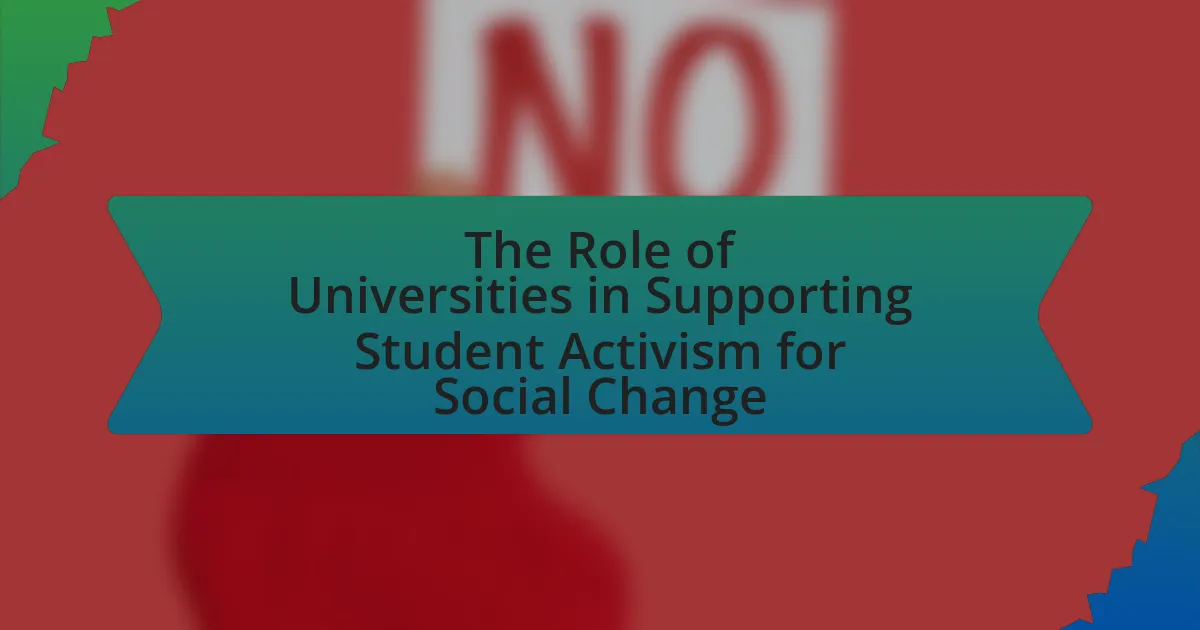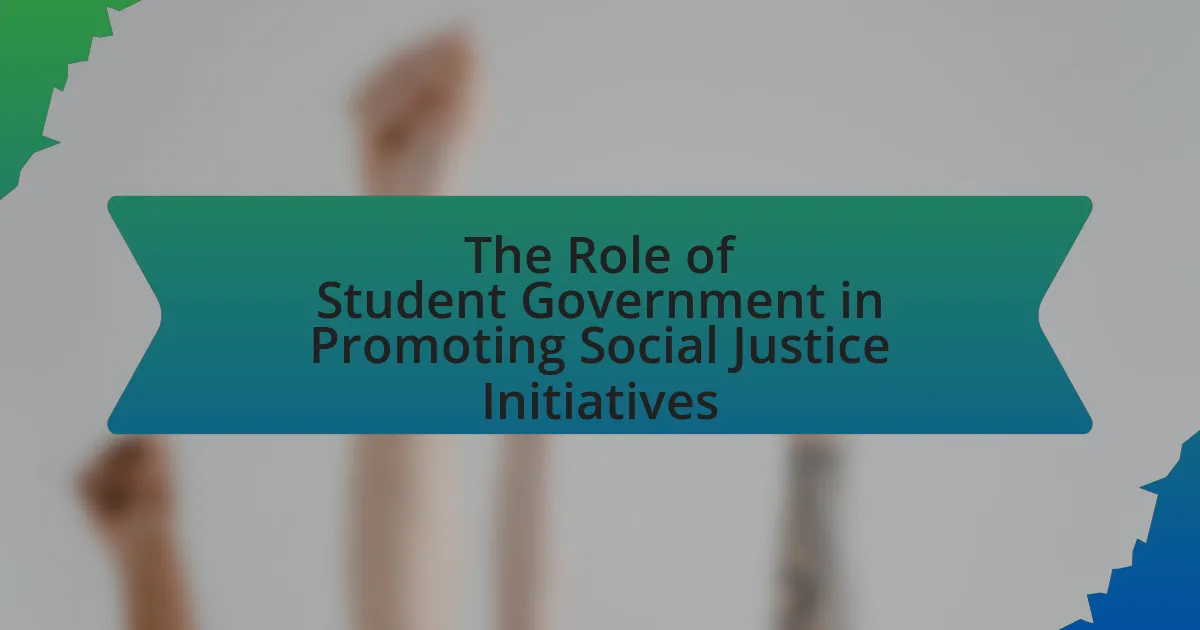Student-led social justice initiatives are programs initiated and managed by students to address social inequalities and promote justice within their communities. This article explores how these initiatives differ from traditional efforts, emphasizing their grassroots nature and the pivotal roles students play as leaders and advocates. It outlines the goals of these initiatives, which include equity and systemic change, and discusses the importance of measuring their impact through qualitative and quantitative methods. Additionally, the article addresses the challenges faced in evaluating these initiatives and offers best practices for effective measurement, highlighting the significance of collaboration and accountability in enhancing evaluation efforts.

What are Student-Led Social Justice Initiatives?
Student-led social justice initiatives are programs or projects initiated and managed by students aimed at addressing social inequalities and promoting justice within their communities. These initiatives often focus on issues such as racial equality, environmental justice, gender rights, and economic disparities. Evidence of their impact can be seen in various successful campaigns, such as the March for Our Lives movement, which was organized by students advocating for gun control after the Parkland shooting in 2018, demonstrating the power of youth activism in effecting social change.
How do these initiatives differ from traditional social justice efforts?
Student-led social justice initiatives differ from traditional social justice efforts primarily in their grassroots nature and focus on youth engagement. These initiatives empower students to take direct action and advocate for change within their communities, often utilizing innovative methods such as social media campaigns and peer education, which contrasts with traditional efforts that may rely more on established organizations and formal structures. Research indicates that student-led initiatives can foster a sense of ownership and responsibility among participants, leading to increased motivation and sustained engagement in social justice issues, as evidenced by studies showing higher levels of civic participation among youth involved in such initiatives compared to those engaged in conventional social justice activities.
What roles do students play in these initiatives?
Students play pivotal roles in social justice initiatives by acting as leaders, advocates, and organizers. They lead campaigns to raise awareness about social issues, advocate for policy changes, and organize events that mobilize their peers and the community. For instance, research shows that student-led initiatives can significantly influence local policies, as seen in the 2018 March for Our Lives movement, where students effectively advocated for gun control legislation. Their involvement not only empowers them but also fosters a culture of civic engagement and social responsibility among their peers.
Why is student leadership important in social justice movements?
Student leadership is crucial in social justice movements because it empowers young individuals to advocate for change and mobilize their peers effectively. This leadership fosters a sense of agency among students, enabling them to identify social injustices and organize collective actions, such as protests and awareness campaigns. Historical examples, such as the role of student activists in the Civil Rights Movement, demonstrate that student-led initiatives can significantly influence public opinion and policy changes. Research indicates that youth involvement in social justice not only enhances their leadership skills but also contributes to sustained engagement in civic activities, thereby amplifying the impact of social justice movements.
What goals do student-led social justice initiatives typically aim to achieve?
Student-led social justice initiatives typically aim to achieve equity, inclusion, and systemic change within their communities. These initiatives focus on addressing social inequalities related to race, gender, economic status, and other marginalized identities. For instance, according to a study by the National Youth Leadership Council, student-led projects often seek to empower peers, raise awareness about social issues, and advocate for policy changes that promote justice and equality. This evidence demonstrates that the primary goals of these initiatives are to foster a more equitable society and to engage students in active citizenship.
How do these goals align with broader social justice movements?
The goals of student-led social justice initiatives align with broader social justice movements by promoting equity, inclusion, and systemic change. These initiatives often address issues such as racial inequality, gender discrimination, and environmental justice, which are central to larger social justice efforts. For example, the Black Lives Matter movement, which advocates for racial equity, has inspired student groups to organize protests and educational campaigns on campuses, thereby amplifying the movement’s objectives. Additionally, research from the National Youth Rights Association indicates that youth activism significantly contributes to social change, demonstrating that student-led efforts can effectively influence public policy and societal norms.
What specific issues are often addressed by these initiatives?
Student-led social justice initiatives often address issues such as racial inequality, gender discrimination, environmental justice, and economic disparity. These initiatives aim to raise awareness and promote action on systemic injustices affecting marginalized communities. For instance, a study by the National Youth Leadership Council found that youth-led projects focusing on racial equity have led to increased community engagement and policy changes in local governance. Additionally, initiatives targeting gender discrimination have been shown to empower young women and foster leadership skills, as evidenced by programs like Girls Who Code, which aims to close the gender gap in technology fields.
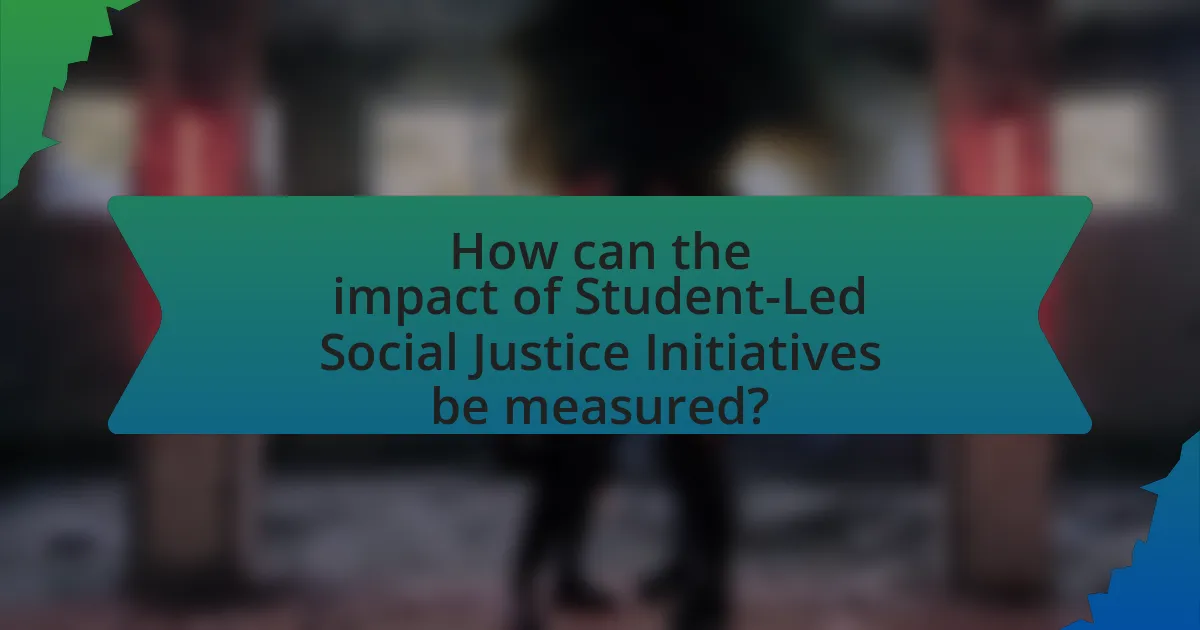
How can the impact of Student-Led Social Justice Initiatives be measured?
The impact of Student-Led Social Justice Initiatives can be measured through qualitative and quantitative assessments, including surveys, interviews, and analysis of community engagement metrics. Surveys can gauge participant satisfaction and perceived changes in awareness or attitudes, while interviews provide deeper insights into personal experiences and outcomes. Additionally, tracking metrics such as the number of participants, events organized, and community feedback can quantify the initiatives’ reach and effectiveness. Research indicates that initiatives with structured evaluation frameworks, such as the Logic Model, enhance the ability to assess impact systematically, allowing for adjustments and improvements based on findings.
What metrics are commonly used to assess the effectiveness of these initiatives?
Common metrics used to assess the effectiveness of student-led social justice initiatives include participant engagement levels, community impact assessments, and feedback surveys. Participant engagement levels can be measured through attendance rates, volunteer hours, and active participation in events, indicating the initiative’s reach and involvement. Community impact assessments evaluate changes in community awareness, attitudes, or behaviors resulting from the initiative, often supported by pre- and post-initiative surveys. Feedback surveys collect qualitative and quantitative data from participants and community members, providing insights into perceived effectiveness and areas for improvement. These metrics collectively offer a comprehensive view of an initiative’s success and areas needing enhancement.
How can qualitative data enhance the understanding of impact?
Qualitative data enhances the understanding of impact by providing in-depth insights into participants’ experiences and perceptions. This type of data captures the nuances of individual stories, emotions, and contextual factors that quantitative data may overlook. For instance, interviews and focus groups can reveal how student-led social justice initiatives influence community attitudes and behaviors, offering a richer narrative that complements numerical findings. Research by Creswell and Poth (2018) emphasizes that qualitative methods allow for a deeper exploration of complex social phenomena, thereby enriching the overall evaluation of impact.
What quantitative methods are effective for measuring success?
Surveys and statistical analysis are effective quantitative methods for measuring success in student-led social justice initiatives. Surveys can collect data on participant engagement, awareness, and behavioral changes, while statistical analysis can evaluate the impact of these initiatives by comparing pre- and post-initiative metrics. For instance, a study by the American Educational Research Association found that using pre- and post-surveys can quantitatively assess changes in student attitudes and knowledge regarding social justice issues, providing concrete evidence of the initiative’s effectiveness.
Why is it important to measure the impact of these initiatives?
Measuring the impact of student-led social justice initiatives is crucial for assessing their effectiveness and informing future actions. By quantifying outcomes, stakeholders can identify successful strategies and areas needing improvement, ensuring resources are allocated efficiently. Research indicates that initiatives with measurable impacts are more likely to secure funding and support; for instance, a study by the Stanford Social Innovation Review found that organizations demonstrating clear metrics of success attract 50% more funding than those without. This evidence underscores the importance of measurement in driving accountability and enhancing the overall impact of social justice efforts.
How does measuring impact contribute to future initiatives?
Measuring impact directly informs future initiatives by providing data-driven insights into what strategies are effective and which areas require improvement. This evaluation allows organizations to allocate resources more efficiently, ensuring that successful methods are replicated while less effective approaches are revised or abandoned. For instance, a study by the Stanford Social Innovation Review found that organizations that measure their impact are 50% more likely to achieve their goals compared to those that do not. This evidence underscores the importance of impact measurement in shaping future social justice initiatives, enabling them to be more targeted and effective.
What role does accountability play in the measurement process?
Accountability is crucial in the measurement process as it ensures that individuals and organizations are responsible for their actions and outcomes. In the context of measuring the impact of student-led social justice initiatives, accountability fosters transparency and encourages stakeholders to engage in honest evaluations of their efforts. Research indicates that when accountability mechanisms are in place, such as regular reporting and feedback loops, the quality of data collected improves, leading to more accurate assessments of initiative effectiveness. For instance, a study by the American Educational Research Association highlights that accountability frameworks enhance the reliability of measurement tools used in educational settings, thereby providing a clearer picture of the initiatives’ impacts.
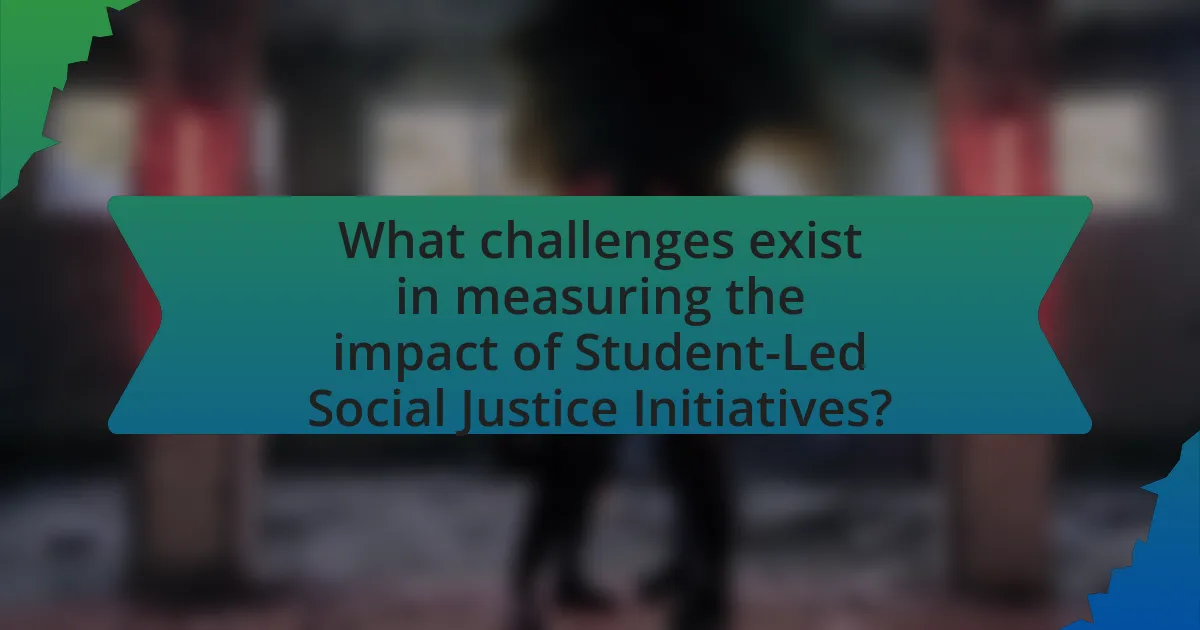
What challenges exist in measuring the impact of Student-Led Social Justice Initiatives?
Measuring the impact of Student-Led Social Justice Initiatives faces several challenges, primarily due to the subjective nature of social justice outcomes and the difficulty in quantifying qualitative changes. These initiatives often aim to address complex social issues, making it hard to establish clear metrics for success. For instance, while a project may increase awareness or engagement among students, translating these changes into measurable outcomes like policy shifts or community improvements is challenging. Additionally, the diverse goals and methods of different initiatives complicate standardization in measurement, leading to inconsistencies in data collection and analysis. Furthermore, the reliance on self-reported data can introduce bias, as participants may overstate their involvement or the initiative’s effectiveness. These factors collectively hinder the ability to accurately assess the true impact of these initiatives.
What are common obstacles faced during the evaluation process?
Common obstacles faced during the evaluation process of student-led social justice initiatives include lack of clear objectives, insufficient data collection methods, and limited stakeholder engagement. These challenges hinder the ability to accurately assess the impact of initiatives. For instance, unclear objectives can lead to misaligned evaluation criteria, while inadequate data collection may result in incomplete or biased findings. Additionally, limited engagement from stakeholders, such as students and community members, can restrict the evaluation’s comprehensiveness and relevance, ultimately affecting the validity of the results.
How can bias affect the measurement of impact?
Bias can significantly distort the measurement of impact by skewing data collection and interpretation processes. When evaluators hold preconceived notions or preferences, they may selectively gather information that aligns with their views, leading to incomplete or inaccurate assessments of the initiative’s effectiveness. For instance, if a study on student-led social justice initiatives primarily includes feedback from participants who are already supportive of the cause, it may overlook critical perspectives from dissenting voices, resulting in an inflated perception of success. Research indicates that confirmation bias can lead to a misrepresentation of outcomes, as seen in various social science studies where biased sampling resulted in misleading conclusions about program efficacy.
What limitations do existing measurement tools have?
Existing measurement tools for assessing the impact of student-led social justice initiatives often lack specificity and adaptability. Many tools are designed for broader educational outcomes and do not capture the unique aspects of social justice initiatives, such as community engagement and individual empowerment. For instance, standardized surveys may not adequately reflect the qualitative changes in participants’ attitudes or behaviors, leading to incomplete assessments. Additionally, existing tools may not account for the diverse contexts in which these initiatives operate, resulting in a one-size-fits-all approach that fails to recognize local nuances. This limitation can hinder the accurate evaluation of effectiveness and the identification of best practices.
How can these challenges be overcome?
To overcome the challenges in measuring the impact of student-led social justice initiatives, institutions can implement standardized evaluation frameworks that incorporate both qualitative and quantitative metrics. These frameworks should include pre- and post-initiative surveys to assess changes in awareness and attitudes, as well as specific performance indicators such as participation rates and community engagement levels. Research by the American Educational Research Association highlights that using mixed-method approaches enhances the reliability of impact assessments, allowing for a comprehensive understanding of outcomes. By adopting these strategies, educational institutions can effectively gauge the success and areas for improvement in their social justice initiatives.
What best practices can enhance the measurement process?
To enhance the measurement process of student-led social justice initiatives, implementing clear objectives and metrics is essential. Establishing specific, measurable, achievable, relevant, and time-bound (SMART) goals allows for focused evaluation. Additionally, utilizing mixed methods, such as qualitative interviews and quantitative surveys, provides a comprehensive understanding of impact. Research by the American Educational Research Association highlights that triangulating data sources increases reliability and validity in measurement. Regularly reviewing and adjusting measurement tools based on feedback ensures they remain relevant and effective.
How can collaboration improve evaluation efforts?
Collaboration can significantly enhance evaluation efforts by integrating diverse perspectives and expertise, leading to more comprehensive assessments. When multiple stakeholders, such as educators, students, and community members, work together, they can identify various metrics and outcomes that reflect the true impact of student-led social justice initiatives. Research indicates that collaborative evaluations often yield richer data, as seen in the study “Collaborative Evaluation: A Review of the Literature” by Chris L. H. H. Wong and colleagues, which highlights that collaborative approaches can improve the validity and reliability of evaluation findings. This collective input not only fosters a deeper understanding of the initiatives but also promotes shared ownership of the evaluation process, ultimately leading to more effective and actionable insights.
What are some practical tips for effectively measuring impact?
To effectively measure impact, establish clear, specific objectives that align with the goals of the student-led social justice initiatives. This clarity allows for targeted data collection and analysis. Utilize both qualitative and quantitative methods, such as surveys, interviews, and focus groups, to gather comprehensive feedback from participants and stakeholders. For instance, a study by the Stanford Social Innovation Review emphasizes the importance of mixed-method approaches in evaluating social initiatives, highlighting that combining numerical data with personal narratives provides a fuller picture of impact. Regularly review and adjust measurement strategies based on initial findings to ensure they remain relevant and effective.
